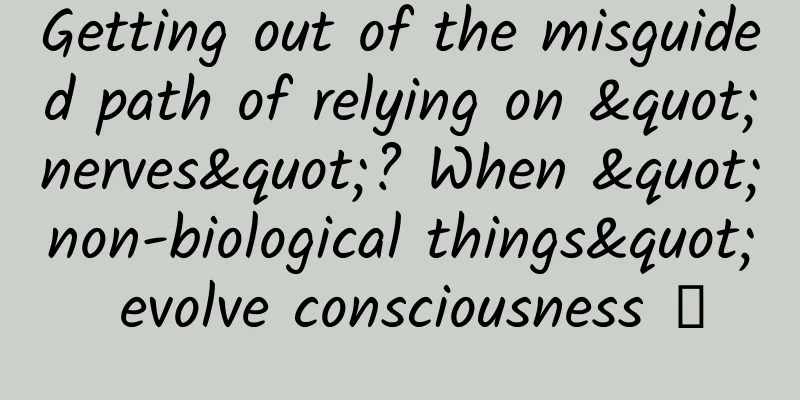Getting out of the misguided path of relying on "nerves"? When "non-biological things" evolve consciousness →

|
© Laszlo Podor/Getty Leviathan Press: It is not difficult to understand the research perspective of neurocentrism derived from anthropocentrism. After all, when we talk about conscious experience, we can only identify and sort it out from our own perspective, such as the experience of pain, the behavior and emotional expression of different brain regions, the recognition of oneself in the mirror, etc. But this is exactly the question the author of this article has: Have we gone astray in our research on consciousness that relies too much on nerves? In other words, if we have enough reason to believe that strong artificial intelligence may evolve consciousness in the future, then will this "non-biological consciousness" give us some new inspiration? Twenty-five years ago, the emerging field of consciousness science was so promising. Cutting-edge neuroimaging tools were enabling entirely new research projects, and neuroscientist Christof Koch was so optimistic that he bet a case of wine that we were about to uncover the secrets of consciousness. Philosopher David Chalmers was skeptical, because studying consciousness is, to put it mildly, "difficult." Even what Chalmers calls "the simple problem of consciousness" is hard, and that's the question at stake: whether we can uncover the neural structures involved in conscious experience. So he took the bet. This summer, amid much hype and media attention, Koch handed Chalmers a case of wine in front of 800 academics. The scientific journal Nature kept score: 1 for the philosopher, 0 for the neuroscientist. Chalmers (left) and Christoph Koch met in New York on June 23, 2023 to settle their previous bet. © Jesse Winter What’s the problem? It’s not that the past 25 years of consciousness research have been fruitless. There has been a wealth of research in the field[1], and the discoveries and applications seem only a step away from science fiction. The problem is that even with all these discoveries, we still haven’t identified any neural structures associated with consciousness. This is why Koch’s bet failed. If “easy problems” are so difficult, then what about the so-called “hard problems”? Chalmers describes the Hard Problem of Consciousness as: Why do material beings like us have experiences? If we can solve this puzzle, we will have a reliable theory of consciousness that can explain the nature of conscious experiences. Philosophers and scientists alike want to solve this difficult problem, and to that end, many are currently focusing on simpler questions. But this focus on easy problems is making the hard problems seem harder than they really are. We may like a difficult puzzle, but we hate a puzzle that has missing conditions. The science of consciousness has more “conditions” today than it did 25 years ago. But there are reasons to think that key conditions are still missing, turning an intellectually challenging puzzle into an unsolvable problem. To understand why, we have to revisit the assumptions that launched the field of consciousness research in the first place. --- Just eight years before Koch and Chalmers made their bet, there was no unified “field of consciousness research” in academia. Some scientists advocated studying animal consciousness, and although there were studies on blindness, amnesia, and split-brain people, these research projects were mostly independent of each other.[2] Animal behaviorist Donald Griffin (1915-2003). © Digital Commons Rockefeller University Calls to study consciousness in some scientific fields have been met with skepticism and derision: For example, animal behaviorist Donald Griffin has written four books advocating for the study of animal consciousness, the first of which was The Question of Animal Awareness (1976). Although Griffin is a well-respected scientist (he co-discovered echolocation in bats), he has not had much success in advancing consciousness research in his field. Students are warned to stay away from the topic, and one cognitive textbook even scoffs at the idea of focusing on animal consciousness because “it seems too rash for an animal psychologist to tread blindly where even philosophers fear to tread.” For many people, consciousness is a taboo subject, like other questions about artificial intelligence, psychedelics, or alien life (all of which, interestingly, are receiving attention from the scientific community today). It can be said that it was Koch's paper "Towards a Neurobiological Theory of Consciousness" (1990) that helped transform consciousness research into a true science. © Wikipedia He co-authored the paper with Francis Crick, who had about as much scientific prestige as you could imagine—after all, he had won a Nobel Prize in 1962 for his role in the discovery of the structure of DNA. Crick and Koch’s proclamation had a huge impact on the establishment of this new science, laying the foundation for its future development: "We should assume that some animal species, especially higher mammals, possess some basic features of consciousness, but not necessarily all of them. For this reason, appropriate experiments with these animals may help to uncover the mechanisms underlying consciousness... We believe that it is not useful at this stage to discuss whether 'lower' animals such as octopuses, fruit flies or nematodes are conscious. However, consciousness is likely to be relevant to some extent in nervous systems of any complexity." Crick and Koch assumed that “higher mammals” possessed some of the basic features of consciousness, meaning they were answering Griffin’s call to study animal consciousness. By taking this bold approach, Crick and Koch set aside the then-prevalent Cartesian view that conscious experience required language: “A language system (of the type found in humans) is not necessary for consciousness. That is, one does not need language to have the key features of consciousness. However, this is not to say that language cannot significantly enrich consciousness.” Crick and Koch rejected the linguistic centrism of the time and provided scientists with more pieces to work with. Specifically, they suggested that scientists focus on an ability that humans share with “higher animals”: vision. The reasons they gave for this choice were pragmatic, but also distinctly anthropocentric and theory-driven: “At this point we would like to propose a somewhat arbitrary personal choice. Since we hypothesize that a very similar basic mechanism of consciousness exists in different parts of the brain (particularly in different parts of the neocortex), we believe that the visual system is most amenable to initial experimental investigation…Unlike language, the visual system is very similar in humans and higher primates. It has already been the subject of a great deal of experimental work by both psychophysicists and neuroscientists. Moreover, we believe that it will be easier to study than the more complex aspects of consciousness associated with self-awareness.” Reading Crick and Koch’s manifesto today is almost eerie, because it so accurately predicted the direction in which consciousness research would develop over the next 33 years, focusing on mammalian vision. In opening up the field of consciousness research, Crick and Koch defined the range of acceptable research objects and research questions. Their view was that we can only look for consciousness based on what we know about it, and what we know about it is human consciousness. The so-called "higher mammals" refers to social primates like us who rely primarily on vision to interact with the world. Today, it is no longer language but the nervous system that is considered necessary for consciousness. What is overlooked is that animals very different from us also use vision. So-called "lower mammals" have eyes, because all mammals have eyes. So do birds, most reptiles, and fish, with only partially blind cave fish having lost the ability. But it's not just these familiar species that have eyes. Scallops have 200 eyes, although scientists still don't know how they work together to help them see. © ShaneKato / iStock Box jellyfish have 24 eyes, divided into four different types, specialized for different tasks.[3] Scallops have about 200 eyes of the same type, all with dilating pupils and two layers of retinas.[4] When consciousness research is based on studies of human-like vision, it makes the field of consciousness research indisputably anthropocentric, ignoring animal models that could be key pieces of the puzzle. More importantly, it also made the field remarkably neurocentric. By including only “higher mammals” in the study of consciousness, Crick and Koch replaced a language-centric view of consciousness with a neurocentric one. Today, it is no longer language but the nervous system that is considered necessary for consciousness. The theory behind Crick and Koch’s proposal assumed that similar neural mechanisms of consciousness existed in different areas of the human brain and that, because certain animals’ nervous systems resembled parts of our own, we could study the brains of these animals — the brains of animals like us. If we insist that consciousness requires a complex brain, then there is no point studying scallops, since they don't even have brains, or jellyfish, since they only have a small neural network of about 10,000 neurons. The Chalmers and Koch bet was made within this framework of firm belief, which is why the stakes were whether science would discover neural structures associated with consciousness. While research based on this approach over the past few decades has failed to provide evidence in favor of a particular theory of consciousness, neuroscience research has indeed been fruitful in a very different and surprising way— it has been used to identify other conscious animals. --- In 2012, scientists held a conference to commemorate the work of Crick, who had died eight years earlier. At the conference, they announced the Cambridge Declaration on Consciousness[5], which stated that there was enough evidence to conclude that “all mammals and birds, and many other creatures including octopuses” experience conscious states and that: "The absence of a neocortex does not appear to prevent organisms from experiencing affective states. There is consistent evidence that non-human animals possess the neuroanatomical, neurochemical, and neurophysiological basis of conscious states and the capacity to display intentional behavior." The Manifesto uses the term "basis of conscious states," which implies that a definitive discovery has been made about the source of consciousness—the "simple question" has been answered. But, as the outcome of the bet shows, we still don't have a solid theory. What the Manifesto identifies are new markers of consciousness, features that provide evidence that the system to which it belongs is conscious. In everyday life, when we view other humans as conscious agents, we rely on markers such as goal-directed behavior, communicative interactions, and emotional expressions. When we view our pets (and other “higher mammals”) as conscious, we rely on these same markers. © Giphy These common markers help us interpret behavior as the result of the agent's desires and information states and help us explain why individuals act as they do. Prescientific markers lead me to believe that my dog, Riddle, likes to go for walks because he gets excited when I pick up the leash. They also lead me to believe that he likes me because if someone else in the family picks up the leash, he looks at me nervously, worried that I won't be able to go out with him. By not turning our attention to other species and other aspects of consciousness, we are making difficult problems even more difficult. The Declaration points to five markers of consciousness derived from scientific research: homologous brain circuits; artificial stimulation of brain regions that induce similar behaviors and emotional expressions in humans and other animals; neural circuits that support behavioral/electrophysiological states of attention, sleep, and decision-making; mirror self-recognition; and similar effects of psychedelic drugs on different species. These five markers are all derived markers - the result of scientific research on humans and higher mammals. © BBC/Dribbble The authors of the manifesto believe that possessing some of these markers is sufficient to prove the existence of consciousness. In the case of octopuses, for example, researchers believe that their neurophysiology is complex enough to conclude that they are likely to be conscious, even though they do not exhibit mirror self-recognition. Mirror self-recognition is one of those behaviors that animals are able to perform without making any assumptions about the physiological mechanisms that support it. You can pass the mirror test by touching or wiping off a mark that someone has secretly left on you. Human children pass this test at around 18 months of age. So do great apes, dolphins, cleaner fish, magpies, Asian elephants, and, more recently, ghost crabs.[6] The mirror self test is not fair to creatures that don't rely primarily on vision. © GIGAZINE But mirror self-recognition is only one marker of consciousness; the others emphasize neurophysiological mechanisms, reflecting the neurocentrism of Crick and Koch. Some evidence of consciousness can be provided by a behavioral test, but for the Manifesto, strong evidence comes from having the right neuroanatomical, neurochemical, and neurophysiological properties. This emphasis on neuroscience may have hindered the development of science. Similarities to human physiology can provide some support for the conclusion that other animals have consciousness, but we should not take our physiology as a necessary condition for consciousness. First, through animal studies, researchers have recognized multiple realizability—the idea that mental abilities can be realized by widely different physical systems. When we simply observe physical systems that are slightly different from our own, we may be missing a key part of the puzzle of consciousness. Perhaps surprisingly, the anthropocentrism of Crick and Koch’s original proposal led to new conclusions about other conscious animals. This shift away from humans might be seen as an invitation for scientists to conduct profitable research on consciousness in new species, such as the octopus. Yet the species scientists study haven’t changed much in the past decade, with most labs still focusing on vision in humans and monkeys, and still clinging to the idea that consciousness correlates with neural complexity. Change is difficult and expensive, especially when it centers on primate research. And by not turning our attention to other species and other aspects of consciousness, we are making hard problems even harder. --- If vision is compared to self-awareness, as Crick and Koch did, it may seem like a simple conscious ability, but the mammalian visual system is a highly evolved feature of the nervous system that emerged more than 200 million years ago. The system has had plenty of time to grow complex. The proposal to study consciousness by studying simpler systems follows standard scientific procedure, as many advances in science begin by studying simpler cases and then move on to more complex ones. © Medium There is a contradiction between our current neurocentrism and the approach of studying simpler systems first. Understanding consciousness by studying complex conscious animals is like reverse engineering a digital calculator to understand how the machine adds numbers, rather than starting with the abacus. In biology, model organisms like Caenorhabditis elegans have played a major role in many scientific discoveries over the past 80 years, with their simple nervous systems and cells that develop and die easily observed. These tiny worms have been used to study everything from nicotine addiction to aging. Why not use them to study consciousness? The answer to this question is also simple: these animals are not considered to be conscious. We see this idea again and again in the literature on consciousness. “Since worms have only about 300 neurons, it would be a huge leap of faith to assume that they can actually feel pain,” writes philosopher Michael Tye in Tense Bees and Shell-shocked Crabs (2016). Neuroscientist Anil Seth echoes this concern in his book Being You (2021): “When we look at the minuscule 302 neurons of the nematode C. elegans, I find it hard to attribute any meaningful state of consciousness to it…” If future AI systems are anything like current ones, they will be very similar to us in terms of their language behavior. The view that worms are not conscious was reflected in a 2020 survey of philosophers’ views on major philosophical questions[7], which also included the question “What kind of entities are conscious?” Most philosophers accept (or tend to accept) that adult humans (95.15%), cats (88.55%), newborns (84.34%), and fish (65.29%) have consciousness. Some are skeptical about flies (34.52%), worms (24.18%), and plants (7.23%) having consciousness. Notably, although this survey was conducted before the launch of Chat-GPT, 39.19% of philosophers surveyed believed that future AI systems will be conscious. © New Scientist If future AI systems are anything but identical to current systems, they will not have neurons, and they will also be very similar to us in their linguistic behavior. Today, even as scientists explore the question of consciousness by studying neural correlates, we are also thinking about non-biological consciousness in AI systems. The question of AI consciousness sits uncomfortably side by side with the neurocentrism of current science. This may be because anthropocentrism drives thinking about what it means to be “conscious” more strongly than neurocentrism, which is a result of the anthropocentric reasoning that drives consciousness research, identifying mammalian-like nervous systems as the key feature. If Chat-GPT pushes researchers away from neurocentrism, we may end up returning to the linguistic centrism that Griffin worked so hard to undermine. That wouldn’t be productive science. But there is another way, which is to expand animal research beyond its current intense focus on mammalian brains. Crick and Koch proposed studying the visual system because we already know a lot about it and the visual systems of different mammals are similar to each other. Another reason they proposed studying the visual system is probably because they believed that vision is often involved in conscious experience. Vision is one of the sensory modalities, and although it is widespread in many animal groups, it is not the only sensory modality, nor is it the first sensory modality to evolve in the animal lineage. Chemoreceptors, which sense chemical properties such as taste and smell, are found in a wide range of animal groups, including C. elegans. This sensory ability allows the worm to sense taste, smell, temperature, and motion, and to form associations through habituation and association. The worms were habituated to artificial tapping and learned to avoid salt ions that had been paired with garlic [8]. They learn, they have memory, and they move in the environment toward things they need and away from things they don’t need. Some researchers are studying consciousness in invertebrates, but such studies tend to focus on identifying markers to provide evidence that animals have consciousness. For example, recent research on consciousness in bumblebees focused on identifying markers of pain experience[9], while a report commissioned by the UK Department for Environment, Food and Rural Affairs found evidence that crabs and octopuses experience pain[10]. --- What would we learn if, instead of focusing on the brain as the physiological part necessary for consciousness, our anthropocentrism led us to study behavior as it relates to experience? We can then study the nature of consciousness by using bees, octopuses, and worms as research subjects. These animals all have a range of behaviours that confirm they are conscious. Turning away from painful stimuli, knowing where ideal nutrients are, and seeking out things needed for reproduction are things we share widely with other animals. The study of consciousness can be greatly simplified by studying other animals such as Caenorhabditis elegans, which show evidence of associative learning and possess sensory systems [11]. © The Intrinsic Perspective Studying consciousness in animal species that lack mammalian nervous systems does not help science avoid anthropocentrism. We are still starting from the human case, considering the kinds of behaviors we ourselves engage in that are relevant to conscious experience—perceiving the environment, feeling pain, and pleasure. That’s okay. Anthropomorphism is inevitable in the study of consciousness, just as it is in our other scientific endeavors. It’s because we are human, and we see things from a human perspective. As the philosopher Thomas Nagel points out, no single perspective emerges in a vacuum, only multiple perspectives from different perspectives. As humans, we have certain shared perspectives, given typical human physiology and life history. But we also have perspectives that are very different from one another. In surveys of philosophers, the view that human infants are mostly conscious, fish are probably conscious, and plants are mostly not conscious is reflected, a cultural perspective that reflects the demographics of today's professional philosophers. What would initial assumptions about consciousness look like if professional philosophers were not predominantly white, male, and WEIRD (Western, educated, industrialized, wealthy, democratic)? We should overturn the popular view of our time that a complex brain is necessary for consciousness. Science can begin by understanding consciousness as a human trait, but it must also confront surprising and even disturbing cases of consciousness in unfamiliar places—in animals that are little known to us because of their size, shape, or habitat. It can be unsettling to discover similarities between ourselves and the smallest, simplest animals, but such similarities also present fascinating puzzles, giving us more pieces to solve them. Focusing on model organisms closely related to humans was probably important in the 1990s and 2000s, when Crick and Koch were first beginning the scientific study of consciousness. At that time, some fields still held significant skepticism about animal consciousness, influenced by linguistic centrism. Now we see that accepting the premise that “higher mammals” are conscious does not lead to a theory of consciousness, but it does lead us to accept that more animals are conscious. Now is the time to include these other species in the study of consciousness. © Kaiser Science Just as Crick and Koch overturned the popular view of their time that language was necessary for consciousness, we should overturn the popular view of our time that a complex brain is necessary for consciousness. Perhaps in a few years we will need to overturn another assumption, and by then we will discover that studying consciousness in biological systems other than animals, such as plants and fungi, will also be beneficial. If we recognize that our initial assumptions are modifiable, and allow them to change in response to new scientific discoveries, we may be able to discover new puzzle pieces that make difficult problems easier. About the author: Kristin Andrews is the York Research Chair in Animal Minds and Professor of Philosophy at York University in Toronto. She is a member of the Board of Governors of the Canadian Bornean Orangutan Society and a Fellow of the Royal Society of Canada. Her books include Animal Minds (2nd edition, 2020) and How to Study Animal Minds (2020). References: [1]www.ncbi.nlm.nih.gov/pmc/articles/PMC7058250/[2]www.pnas.org/doi/10.1073/pnas.1921623117[3]www.nature.com/articles/news050509-7[4]www.smithsonianmag.com/scienc e-nature/what-scallops-many-eyes-can-teach-us-about-evolution-vision-180972099/[5]fcmconference.org/img/CambridgeDeclarationOnConsciousness.pdf[6]pubmed.ncbi.nlm.n ih.gov/37314594/[7]survey2020.philpeople.org/survey/results/5106[8]learnmem.cshlp.org/content/17/4/191[9]www.pnas.org/doi/10.1073/pnas.2205821119[10]www.lse.ac.uk/ news/news-assets/pdfs/2021/sentience-in-cephalopod-molluscs-and-decapod-crustaceans-final-report-november-2021.pdf[11]www.ncbi.nlm.nih.gov/pmc/articles/PMC4282626/ By Kristin Andrews Translated by Kushan Proofreading/Rabbit's Light Footsteps Original article/aeon.co/essays/are-we-ready-to-study-consciousness-in-crabs-and-the-like This article is based on the Creative Commons License (BY-NC) and is published by Kushan on Leviathan The article only reflects the author's views and does not necessarily represent the position of Leviathan |
Recommend
618 How much does it cost to rent Henan Mobile’s high bandwidth?
China Mobile is the largest network operator in C...
Sleeping in on the weekends may reduce your risk of heart disease by 20%! Just get enough sleep →
Compiled by: Gong Zixin Can you really make up fo...
SEM | Click is a technology, conversion is an art, why do we say that?
Over the past few decades, the rapid and innovati...
This year, these world records were set by China!
Recently, the world's largest container ship ...
Solution | 7 industry promotion tips under the influence of the epidemic
The sudden outbreak of the new coronavirus epidem...
Hacker Attack and Defense SQLMAP Practical Edition
Course Description This course starts with SQLMAP...
Is it reasonable to require parents to submit salary statements for kindergarten enrollment? What is the specific situation?
Is it reasonable to require parents to submit sal...
"As long as I don't have a physical examination, I'm not sick"
Speaking of physical examination, The reaction of...
Google I/O conference released Android 8.0. The new features are copied from the native systems of Xiaomi and Samsung. Why is it still worth paying attention to?
This year's Google I/O developer conference i...
Advanced checklist for private domain operators
What is a private domain operator ? As the name s...
App Development Architecture Guide (Google official document translation)
[[192223]] This article is for readers who alread...
Even if you are given a chance to copy, you can’t copy other people’s popular H5. Why?
Typically, a hit H5 has three elements: I. Elemen...
Why do elders always believe the "rumors" in family groups?
Duke Zhou, a founding hero of the Western Zhou Dy...
As a community operator, do you still want to stick with it?
I think there is some truth to these three doubts...
Overseas server rental, overseas server rental
Renting a server overseas means renting a server ...









